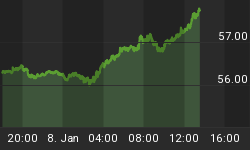Small cap stocks appear to be confirming the bullish signals recently given by oil and precious metals. All three markets point to a central bank induced reflation theme driving asset prices higher. From a fundamental perspective, strength in small caps shows investors are willing to buy stocks of smaller, more volatile, and less established companies.
According to MarketWatch, the Fed may assist in pushing small caps higher:
Supporting momentum from small-cap stocks may come in the form of bank lending incentives from the Fed, according to Michael Jones, chief investment officer of RiverFront Investment Group. Such measures could be announced at the Federal Reserve's retreat in Jackson Hole, Wyo., later this week or at the September Federal Open Market Committee meeting.
The small cap ETF, IWM, has a potentially bullish chart pattern known as an "inverted head-and-shoulders". Stocks, commodities, silver, and gold would all like to see IWM close above 81.53, 81.71 and 81.97. Those levels represent possible resistance based on the pattern shown below.

Since the S&P 500 faces strong resistance between 1,403 and 1,415, we have to remain open to false breakouts. Therefore, even if the bullish set-ups outlined in the video below are followed by weakness in small caps, we will still gather useful information about the health of the current rally in stocks, commodities, and precious metals. Key bull/bear levels for the small cap ETF (IWM) are shown at the 00:16 mark of the video. We will monitor these levels in the days ahead to gain a better understanding of the current rally's sustainability.
After you click play, use the button in the lower-right corner of the video player to view in full-screen mode. Hit Esc to exit full-screen mode.
Eric Marshall, portfolio manager of the Hodges Small Cap Fund, told MarketWatch why he believes small caps offer more attractive valuations than their large-cap brethren:
"Stocks were mispriced because people were focused on Greek and Spanish bond yields and less focused on company fundamentals," Marshall said. "Those kinds of market inefficiencies get exaggerated in the small-cap space."
Another widely utilized pattern by traders is the "cup-with-handle" formation. The handle represents the last wave of selling (or doubt) before a market can move higher. It is possible to see two cup-and-handle formations on the chart of IWM below.

Our respect for the significant overhead resistance facing stocks was a driving force to book profits in the oil services ETF (OIH), a position we established back in late June. If small caps, precious metals, and foreign stocks can hold their breakouts, we will turn to our short list of buy candidates, which includes regional banks (KBE), small caps (IWM), and agricultural commodities (DBA).
To feel better about the bullish case, we would like to see the S&P 500 close above 1,415 on a weekly basis. Should conditions deteriorate further, we are happy to raise additional cash. With the Fed and ECB just around the corner, flexibility is more important than ever.
















